This morning when I woke up I was thinking about the various chores I had to complete during the day and my thoughts ran to my blog. I hadn’t posted a recipe in more than two weeks! I am going to conveniently blame it on the long holidays we had. A whole 9 days of Eid holidays (half of which we chose to spend in Muscat (Oman) with our family friends) was at our disposal. Like we did last year, we chose to drive down to the neighbouring country and I must say that the journey was splendid (couldn’t think of a better word to describe it). A couple of days before we left I had made these fritters at home and decided to make them again at our friends’ place but simply didn’t find the time as we were busy doing nothing but chat endlessly and relax. Breaks like these are what we always welcome as it helps us unwind and get back to the grind feeling totally rejuvenated.
Back to today’s recipe, although I have grown up seeing the plant and knew it had medicinal value I didn’t quite bother to experiment with its leaves. It was in early 2015 that one of my friends with a green thumb gave me a plant during the monthly plant exchange activity conducted at the local Farmer’s Market here in Dubai. I was fascinated at the way the plant grew in leaps and bounds with minimal maintenance or water. It is so sturdy that it withstood the extreme weather conditions (50 degrees C of the harsh desert summer) last year and thrived on while all my other plants died before I was back from my vacation in India.
What I also love about this plant is that if you let the leaves kiss your fingers as you brush against them you will be rewarded with this amazing aroma of carom seeds (ajwain) that lasts for several minutes. My little daughter loves to pluck some leaves and chew on them (under my supervision ofcourse). If you don’t have this plant, its about time you got one cuz soon you will see more recipes using the leaves in some form or the other (juice, herbal tea, chutney etc).
This is among my favourite plants in my kitchen garden (I usually love growing herbs). If you are keen to know more about its medicinal uses, a quick Google search will help you. But if you are lazy to do that, here’s what you need to know. The Indian borage is known for its ability to build your immunity against the common cold, imrove the quality of your skin, relieve stress and anxiety and aid digestion. While crushing the leaves to extract fresh juice is the best way to consume it, the fritters are a great way to introduce the leaves to fussy eaters as you can barely taste the leaves which are a tad bitter and what’s more, they are a wonderful accompaniment to your evening cuppa chai.
Sometimes that’s all we need in life. A plate of piping hot sambarballi podi, piping hot cups of chai and some friends to share it with!
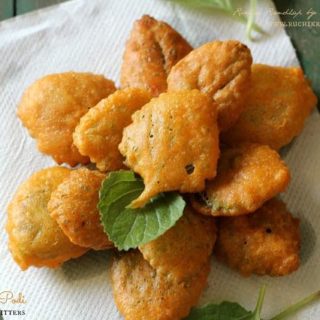
Sambarballi Podi | Doddapatre Baje ~ Indian Borage/Cuban Oregano Fritters
Delicious fritters made from the leaves of Indian Borage. These pair very well with any chutney or dip of your choice, perfect for tea time
Print
Pin
Rate
Ingredients
- 22-25 big Indian borage leaves
- oil for deep frying
For the batter/coating:
- 1/2 cup gram flour/ chick pea flour/besan
- 1/2 tablespoon rice flour
- 1/2 tsp chilli powder adjust to taste
- 1 pinch asafoetida hing
- 1 pinch carom seeds ajwain
- 1 pinch cumin jeera
- 1 pinch turmeric powder
- 1 pinch baking soda / eating soda/ soda bi-carb
- Water as required approx 1/2 cup * see notes
- Salt to taste approx 1/2 tsp of tablesalt
Instructions
- Make sure that the leaves are plucked along with a part of the stem intact. Place them in a large bowl of water and gently cleanse them without breaking them. Do this until all the dirt is gone. Transfer onto a colander to drain off excess water. Then gently and carefully pat each one dry (don’t skip this step as any traces of water will lead to oil splattering all over during the deep frying stage)
- In a shallow bowl mix all the ingredients mentioned under ‘For the batter’ except the water. Add the water in parts until you get a smooth, lump free and flowing consistency (see notes#2 and 3 before proceeding).
- Heat oil for deep frying in a kadai/wok and test the readiness of the oil by putting a drop of the batter into the oil, if it comes up within 4-5 seconds the oil is ready. If it comes up too quickly, the oil is too hot. We need oil that is medium hot.
- While the oil is heating up, dip the leaves (including the stem portion) into the prepared batter. Place as many leaves as you are going to fry in one batch (taking care to see that you don’t overcrowd the pan). You must keep a batch of leaves ready as you need to slip them into the oil one after the other. Don’t dip one at a time and then release them into the oil as those that went into the oil first will burn quickly. Also, make sure that the leaves don’t fold up after being dipped in the batter as they will remain that way when you release them into the oil.
- When all the leaves are into the oil let them fry for a few seconds before gently flipping them over. When they turn golden brown on both sides remove them using a large slotted ladle and shake to drain excess oil. Then transfer onto an absorbent kitchen tissue. Repeat the process till all the leaves are fried
- Serve hot immediately. They taste great without any accompaniment but ketchup or any dip of your choice will work well too.
Notes
1. The addition of baking soda is optional but helps the fritters to puff up and the covering doesn’t stick to the leaf but forms a cavity (as seen in picture above).
2. The amount of water required to make the batter will depend on the texture ie how finely it has been ground (how fine or gritty the flour is). Chickpea flour is available in varying textures to be suitable in the preparation of several sweets and savouries, so just keep adding the water in parts until you get the right consistency.
3. To test the consistency, just drop the batter from height into the bowl – it should be a thin paste like stream and form droplets while falling. If it is too runny it won’t coat the slices properly. Too thick and the coating won’t cook while frying.
4. It is important that the oil is maintained on a medium-high temperature. If it is too hot (high) then the fritters will brown too soon on the outside and remain uncooked inside. Reduce the heat and wait for the oil to cool till just right. If the oil is not hot enough the fritters will absorb too much oil and remain flat (un-crisp) even after frying for a long time.
2. The amount of water required to make the batter will depend on the texture ie how finely it has been ground (how fine or gritty the flour is). Chickpea flour is available in varying textures to be suitable in the preparation of several sweets and savouries, so just keep adding the water in parts until you get the right consistency.
3. To test the consistency, just drop the batter from height into the bowl – it should be a thin paste like stream and form droplets while falling. If it is too runny it won’t coat the slices properly. Too thick and the coating won’t cook while frying.
4. It is important that the oil is maintained on a medium-high temperature. If it is too hot (high) then the fritters will brown too soon on the outside and remain uncooked inside. Reduce the heat and wait for the oil to cool till just right. If the oil is not hot enough the fritters will absorb too much oil and remain flat (un-crisp) even after frying for a long time.
Disclaimer
The nutritional values are only indicative.
Tried this recipe?Please leave a comment & rate the recipe below or share a photo on Instagram and tag me @ruchikrandhap
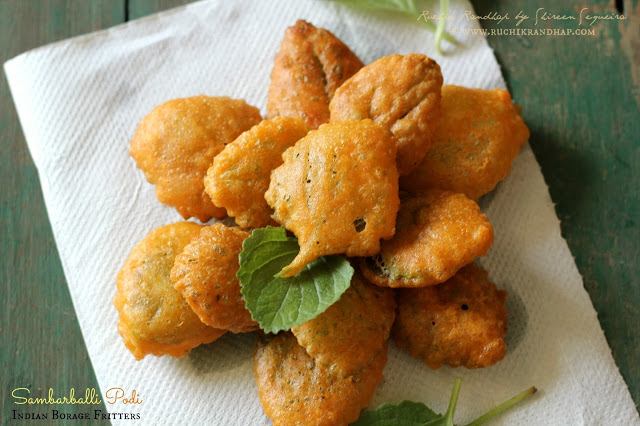
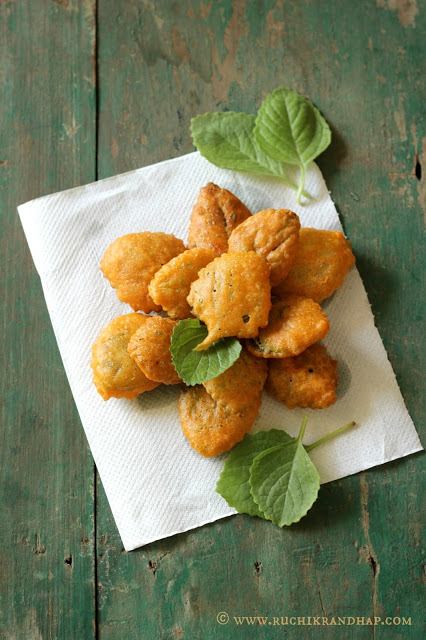
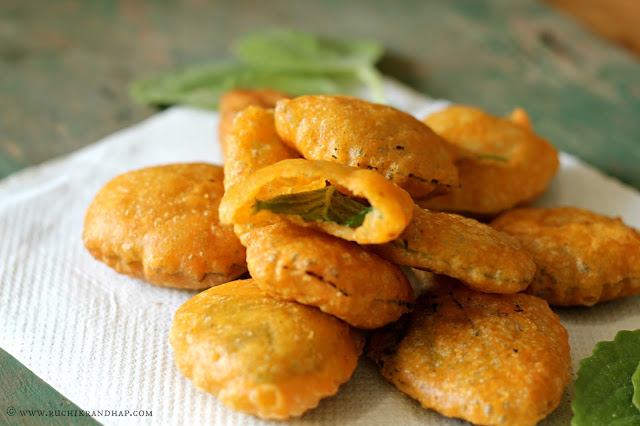
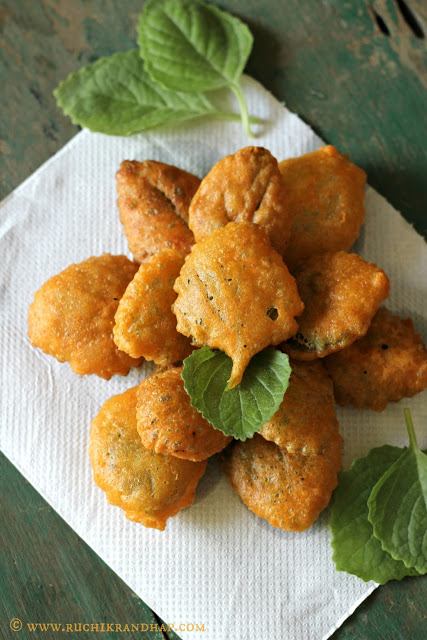
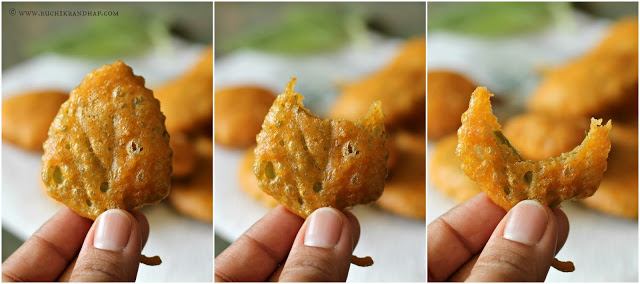
Recently bought home a samabarballi plant ,precisely about two months ago and saw a recipe posted on your site on samabarballi leaves.very interesting and enticing recipe.pictures and presentation are bang on